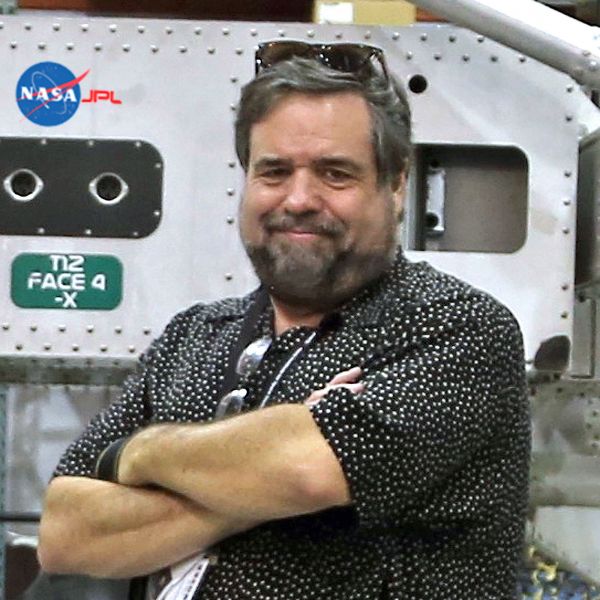This Week In Space podcast: Episode 137 — Strange New Worlds
Kepler's Legacy With Dr. Jason Steffen
On Episode 137 of This Week In Space, Rod Pyle and Tariq Malik talk with Dr. Jason Steffen, a professor of physics at UNLV and a member of the science team for the Kepler Space Telescope mission. This mission finally ended in 2018, but the discoveries keep coming. Kepler returned so much data that it was like "drinking from a firehose," Jason tells us.
As many know, Kepler made massive strides in identifying a couple thousand verified exoplanets in its 4-year prime mission, but less known is its amazing transition to the follow-on mission. When two of its reaction wheels (maneuvering devices) failed by 2013, NASA turned to the science team for advisement, and the K2 (Kepler 2) mission was born, seeking to continue the work by aiming the telescope in a given direction and using the pressure of solar wind on its solar panels to keep it oriented.
Also of interest to us is the fact that this 37-inch space telescope, which follows Earth in its orbit around the sun, is essentially a giant photometer, much like a focused light meter you might have used with your camera in the old days--except bigger and a wee bit more expensive.
It's a fun episode, so join us for "Strange New Worlds" on TWiS.
Download or subscribe to this show at: https://twit.tv/shows/this-week-in-space.
Get episodes ad-free with Club TWiT at https://twit.tv/clubtwit
Space news of the week
- Who Walks Among Us?
- Is SLS a dead rocket walking?
- Did we kill life on Mars?
- Uranus News (a rarity)
- Kepler Exoplanet Mission
- Prof. Jason H. Steffen
- Hidden in the Heavens: How the Kepler Mission’s Quest for New Planets Changed How We View Our Own
Model Falcon 9!

Looking for a telescope to see planets and comets? We recommend the Celestron Astro Fi 102 as the top pick in our best beginner's telescope guide.
Finally, did you know you can launch your own SpaceX rocket? Model rocket maker Estes' stunning scale model of a Falcon 9 rocket that you can pick up now. The launchable model is a detailed recreation of the Falcon 9 and retails for $149.99. You can save 10% by using the code IN-COLLECTSPACE at checkout, courtesy of our partners collectSPACE.com.
About This Week In Space
This Week in Space covers the new space age. Every Friday we take a deep dive into a fascinating topic. What's happening with the new race to the moon and other planets? When will SpaceX really send people to Mars?
Get the Space.com Newsletter
Breaking space news, the latest updates on rocket launches, skywatching events and more!
Join Rod Pyle and Tariq Malik from Space.com as they tackle those questions and more each week on Friday afternoons. You can subscribe today on your favorite podcatcher.

Rod Pyle is an author, journalist, television producer and Editor-in-Chief of Ad Astra magazine. He has written 18 books on space history, exploration, and development, including Space 2.0, Innovation the NASA Way, Interplanetary Robots, Blueprint for a Battlestar, Amazing Stories of the Space Age, First On the Moon, and Destination Mars
In a previous life, Rod produced numerous documentaries and short films for The History Channel, Discovery Communications, and Disney. He also worked in visual effects on Star Trek: Deep Space Nine and the Battlestar Galactica reboot, as well as various sci-fi TV pilots. His most recent TV credit was with the NatGeo documentary on Tom Wolfe's iconic book The Right Stuff.

Responsible for Space.com's editorial vision, Tariq Malik has been the Editor-in-Chief of Space.com since 2019 and has covered space news and science for 18 years. He joined the Space.com team in 2001, first as an intern and soon after as a full-time spaceflight reporter covering human spaceflight, exploration, astronomy and the night sky. He became Space.com's managing editor in 2009. As on-air talent has presented space stories on CNN, Fox News, NPR and others.
Tariq is an Eagle Scout (yes, he earned the Space Exploration merit badge), a Space Camp veteran (4 times as a kid, once as an adult), and has taken the ultimate "vomit comet" ride while reporting on zero-gravity fires. Before joining Space.com, he served as a staff reporter for The Los Angeles Times covering city and education beats. He has journalism degrees from the University of Southern California and New York University.
Join our Space Forums to keep talking space on the latest missions, night sky and more! And if you have a news tip, correction or comment, let us know at: community@space.com.

Space.com is the premier source of space exploration, innovation and astronomy news, chronicling (and celebrating) humanity's ongoing expansion across the final frontier. Originally founded in 1999, Space.com is, and always has been, the passion of writers and editors who are space fans and also trained journalists. Our current news team consists of Editor-in-Chief Tariq Malik; Editor Hanneke Weitering, Senior Space Writer Mike Wall; Senior Writer Meghan Bartels; Senior Writer Chelsea Gohd, Senior Writer Tereza Pultarova and Staff Writer Alexander Cox, focusing on e-commerce. Senior Producer Steve Spaleta oversees our space videos, with Diana Whitcroft as our Social Media Editor.
-
Dave Space.com is a very popular website that provides news in astronomy. We all enjoy its news columns and podcasts. Its expertise is unparalleled. One of its best features however, is its comments section. Topics such as 'Life on Other Worlds' and 'UAP Disclosure' are fascinating and provide a wide interest to the public. It is disappointing that the comments section has been shutdown prematurely with regards to popular stories. A recent story concerning AARO was not open to further replies at all. Why not 'allow' comments on popular stories? There will always be two sides to every story.Reply -
COLGeek Discussions are brought to an end for a variety of reasons. Often, as a result of multiple members straying off the original topic. When closed, it is for the good of the community, to prevent unintended consequences.Reply










